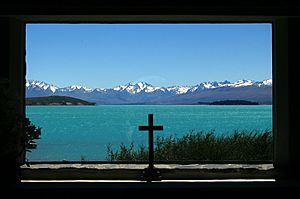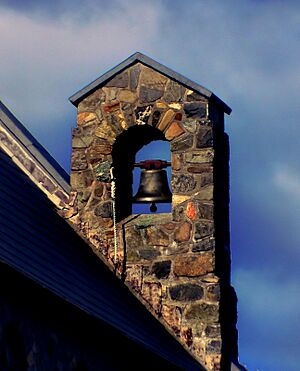Church of the Good Shepherd, Lake Tekapo facts for kids
Quick facts for kids Church of the Good Shepherd |
|
|---|---|

Church of the Good Shepherd with Lake Tekapo and the Southern Alps as a backdrop
|
|
| 44°00′12″S 170°28′57″E / 44.00333°S 170.48250°E | |
| Location | Pioneer Drive, Lake Tekapo, Mackenzie District |
| Country | New Zealand |
| Denomination | Interdenominational |
| History | |
| Status | Parish church |
| Consecrated | 3 August 1935 |
| Architecture | |
| Functional status | Active |
| Architect(s) | Richard Strachan De Renzy Harman |
| Specifications | |
| Materials | Concrete faced with stones |
The Church of the Good Shepherd is a famous little church located right by Lake Tekapo on the South Island of New Zealand. It's an Anglican church, but people from different Christian groups use it. It was built in 1935 to remember the first people who settled in the area. This church is super popular and is one of the most photographed buildings in New Zealand! It's also a very important historical site, recognized by Heritage New Zealand.
Why the Church Was Built
In February 1933, a vicar named Walter Ernest Detheridge Davies arrived in Fairlie. His church area was very large, reaching all the way to Mount Cook Village. Davies realized that the Mackenzie Basin needed its own church.
He first suggested this idea to his church members in September 1933. Davies also had a cool idea: he wanted a huge window in the church. This window would let people inside enjoy the amazing view of the lake, just like at St James Church in Franz Josef.
Local landowners loved the idea. They thought building a church would be a great way to honor the brave pioneers who first settled in the area. The land for the church was generously given by the owners of Braemar Station, a large farm near Lake Tekapo. This land was given so the church would always have its own special space.
A local artist named Esther Hope drew some first ideas for the church. A Christchurch architect, Richard Strachan De Renzy Harman, then used her drawings to create the final design in 1933 and 1934.
Building the Church
The first stone for the church was laid on January 16, 1935. A special guest, Prince Henry, Duke of Gloucester, helped with this ceremony. The bishop of Christchurch and Vicar Davies were also there.
The building team wanted the church to look like it belonged in nature. They decided to leave the plants around the church as they were. The church walls were covered with local stones, and they even left the natural lichen on the stones to make it look even more natural. The main structure of the church was made from concrete, with the stones added on the outside.
Fred Trott won the job to build the church. However, the actual work was done by Les Loomes and Doug Rodman. Doug Rodman was engaged to Fred Trott's daughter. A stonemason from Christchurch, Jack Miller, did all the beautiful stonework. A company from Christchurch also put on the wooden roof shingles.
A bell was donated for the church by the Barker and Sealy families. It was given to remember Audrey Barker, who passed away in February 1935 at just 21 years old. It also honored her grandfather, Edward Sealy, who had explored many glaciers in the area in the 1860s. The bell was made in Christchurch. The church was officially opened and blessed on August 3, 1935, by the Bishop of Christchurch.
Even before the church was finished, a newspaper in Christchurch, The Press, wrote:
The whole effect of the little church is striking and has won the admiration of all who have seen it.
—The Press staff writer, 26 July 1935 article
Church History
Doug Rodman, one of the builders, was the first person to get married in the new church! He married Peggy Trott on December 14, 1935.
The original roof shingles were made of Australian oak. But the weather in the Mackenzie Basin is very harsh, and these shingles didn't last. So, in 1957, the roof was changed to stronger slate shingles.
On September 5, 1985, the Church of the Good Shepherd was officially recognized as a very important historical building. It was given a Category I status by the New Zealand Historic Places Trust, which is now called Heritage New Zealand.
This church is one of the most photographed buildings in all of New Zealand. Because so many tourists were taking photos inside, it started to disturb church services. So, photography inside the building is no longer allowed.
In late 2017, a fence was put around the church grounds. This was because visitors were damaging the area, being rude to staff, and interrupting church services. Now, you can still visit the church grounds during the daytime.
As of 2018, the local vicar estimated that about 600,000 people visit the church every year! That's a huge number of visitors for such a small church.
See also
- List of historic places in Mackenzie District



